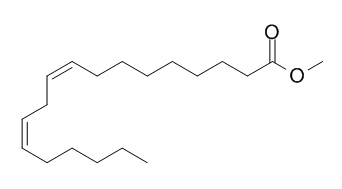Methyl linoleate
Methyl linoleate has antioxidant activity.
Inquire / Order:
manager@chemfaces.com
Technical Inquiries:
service@chemfaces.com
Tel:
+86-27-84237783
Fax:
+86-27-84254680
Address:
1 Building, No. 83, CheCheng Rd., Wuhan Economic and Technological Development Zone, Wuhan, Hubei 430056, PRC
Providing storage is as stated on the product vial and the vial is kept tightly sealed, the product can be stored for up to
24 months(2-8C).
Wherever possible, you should prepare and use solutions on the same day. However, if you need to make up stock solutions in advance, we recommend that you store the solution as aliquots in tightly sealed vials at -20C. Generally, these will be useable for up to two weeks. Before use, and prior to opening the vial we recommend that you allow your product to equilibrate to room temperature for at least 1 hour.
Need more advice on solubility, usage and handling? Please email to: service@chemfaces.com
The packaging of the product may have turned upside down during transportation, resulting in the natural compounds adhering to the neck or cap of the vial. take the vial out of its packaging and gently shake to let the compounds fall to the bottom of the vial. for liquid products, centrifuge at 200-500 RPM to gather the liquid at the bottom of the vial. try to avoid loss or contamination during handling.
J of Ana. Chem.2019, 74(11):1113-1121
Phytomedicine.2018, 38:12-23
Biosci Biotechnol Biochem.2021, 85(10):2153-2160.
Journal of Apicultural Research2021, 60(1)
Heliyon2022, 8(2):e08866.
Spectrochim Acta A2019, 210:372-380
Chem Biol Interact.2016, 260:168-175
Mutlu Yanic S, Ates EG. JOTCSA.2023, 10(4);893-902.
Journal of Third Military Medical University2018, 40(12):1073-1078
Fitoterapia.2024, 175:105955.
Related and Featured Products
Chemical Society of Japan, 1984, 48(4):985-989.
The Photoxidative Alteration of Chlorophylls in Methyl Linoleate and Prooxidant Activity of Their Decomposition Products[Reference:
WebLink]
METHODS AND RESULTS:
Methyl linoleate containing chlorophylls and/or pheophytins was exposed to light in the presence of oxygen. The photooxidative reaction of both chlorophylls a and b was first-order, and the reaction rate for chlorophyll a was higher than that for chlorophyll b. On the other hand, pheophytins a and b hardly decomposed even after irradiation for 24 hr, and retained a green or a brownish-green color. In qualitative analysis of the photooxidation products of chlorophylls a and b, no pheophytins or pheophorbides were detected, while green and polar red pigments were observed on a thin layer chromatogram near the spot of chlorophyll and the origin, respectively.
CONCLUSIONS:
These photooxidation compounds also had prooxidant effects as well as did chlorophyll.
Nihon-suisan-gakkai-shi, 2008, 41(41):263-269.
Effect of Dietary Methyl Linoleate and Linolenate on Growth of Carp—II[Reference:
WebLink]
METHODS AND RESULTS:
The preliminary feeding experiment on growth of carp fingerlings with fat-free, Methyl linoleate and linolenate diets was conducted to determine the carp requirement for essential fatty acids (EFA) as compared with that of rainbow trout. Neither mortality nor abnormality was recognized in experimental fish throughout the feeding trial period, differing con-siderably from the case for rainbow trout which showed a “shock syndrome” on the fat-free diet. Feeding on a fat free diet resulted in the lowest growth, however judging from the percent gain and feed conversion, growth was not as poor as in the case of the rainbow trout. The addition of 5% methyl laurate to the fat-free diet noticeably improved the weight gain. These results indicate that the lowest growth rate obtained in the fat-free group may be partly a result of the lower caloric content due to the absence of fat. In other experimental groups, there was no significant difference in growth and feed conversion due to dietary lipids.
CONCLUSIONS:
The results obtained in this study demonstrate that the EFA requirement of carp is much lower than that of rainbow trout and that carp can grow without abnormality for a fairly long period without EFA.



